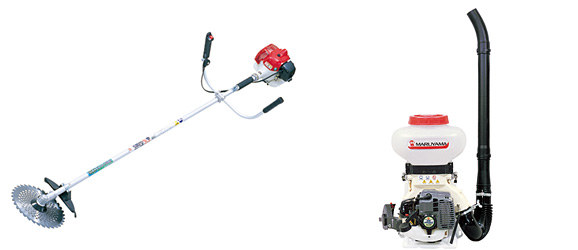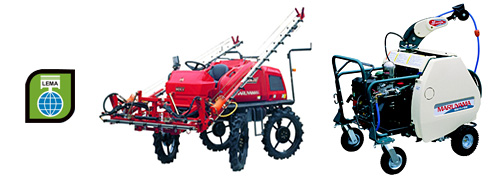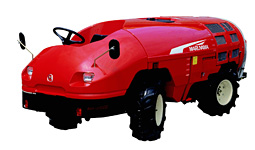Compliance with Engine Emission Regulations (2-Stroke Engines)
The history of engine emission regulations can be traced back to the pollution problems caused by cars in the 1970s. Since then, as environmental regulations on cars have become stricter, the gas emission contribution ratio of non-vehicle (off-road) engines has seen a proportionate increase. Starting with California in the 1990s, this has led to the widespread and worldwide adoption of gas emission regulations targeting off-road engines. All of the 2-stroke engines manufactured by Maruyama meet the gas emission standards adopted by each country, and the other engines employed in Maruyama products also comply with all relevant regulations.
Regulation of 2-stroke engine gas emissions
In Japan, engine gas emissions are regulated by means of voluntary industry standard established by the Japan Land Engine Manufacturers Association. In the U.S.A., engine gas emissions are regulated by legally binding standards enforced by the EPA (Environmental Protection Agency), and in Europe, by a legally-binding EC directive (the contents of which are ratified into law in each member state).
The 2-stroke engines used in equipment such as brushcutters fall into the "portable" category, and are divided into three engine classes. The regulations target the emission of HC + NOx and CO.
HC + NOx: Total combined amount of hydrocarbons and nitrogen oxides emitted
CO: Carbon monoxide
Emitted amount g/kWh: Amount of substance emitted (grams) per kilowatt of energy generated by an engine when operating for one hour
Maruyama's 2-stroke engines meet the gas emission levels prescribed by the industry's non-binding standards.
Example of portable equipment that uses 2-stroke engines

Emission regulations established by the Japan Land Engine Manufacturers Association
Secondary Standards (In-Use Regulations (Note 2))
| Engine Class | Emitted Amount (cc) | HC+NOx (g/kW-hr) |
CO (g/kW-hr) |
Service Life Time (hrs) (Note 3) |
|||
|---|---|---|---|---|---|---|---|
| Engines for Non-portable Equipment |
I-A | Less than 66 | 50 | 610 | 50 | 125 | 300 |
| I-B | Between 66 and 99 | 40 | 610 | 125 | 250 | 500 | |
| I | Between 100 and 224 | 16.1 | 610 | 125 | 250 | 500 | |
| II | 225 or more | 12.1 | 610 | 250 | 500 | 1000 | |
| Engines for Portable Equipment |
III | Less than 20 | 50 | 805 | 50 | 125 | 300 |
| IV | Between 20 and 49 | 50 | 805 | 50 | 125 | 300 | |
| V | 50 or more | 72 | 603 | 50 | 125 | 300 | |
Note 2: In-use regulations indicate standards that must be met within the specified service life of the equipment.
Note 3: A different service life is specified by member companies for each engine family.
Engines that meet the voluntary industry standards sport the following label:

Compliance with regulations at Maruyama
The Engine Development Department has succeeded in developing technologies that allow engines to meet regulations without using exhaust after-treatment devices.
- Link to M-Project (Clean-emission engines)
Reference: Equipment that uses other than 2-stroke engines
Maruyama does not manufacture 4-stroke gasoline engines or diesel engines; however, the engines we procure for our equipment are all clean-emission engines.
4-stroke gasoline engines and diesel engines with a rated power output of 19 kW or less
These engines are regulated by voluntary industry standards established by the Japan Land Engine Manufacturers Association, in the same way as 2-stroke engines.

Diesel engines with a power output of 19 kW or more
These engines are regulated by the Road Transport Vehicle Law and the Act on Regulation, Etc. of Emissions From Non-road Special Motor Vehicles (legally binding regulations).

Links

